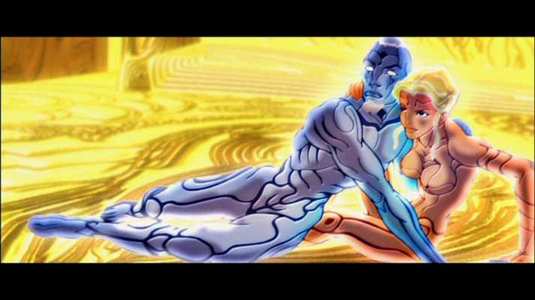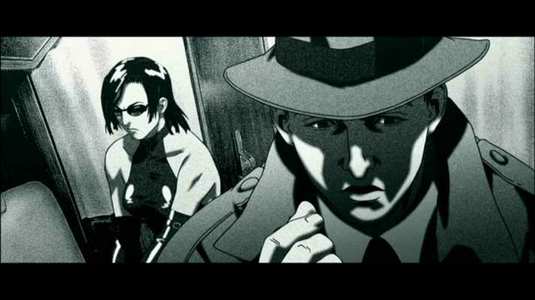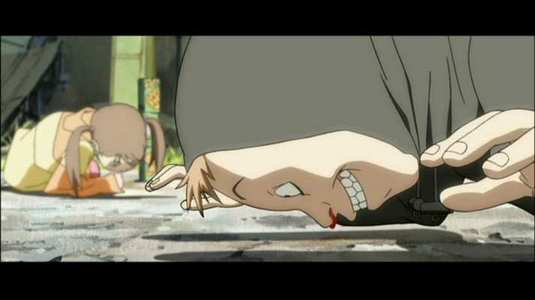Review of Animatrix, The
Introduction
I can`t believe that this disc went by without being reviewed for so long on this site. I can`t believe that I let an anime title slide for this long without reviewing it. And besides, this is the Matrix, a film that practically established DVD as a medium. You would think it a priority to grab all things Matrix related and go over them with a fine-tooth comb, just because of that initial film`s importance to DVD. Alas, the Matrix sequels quickly put paid to my enthusiasm in that regard. The Wachowski brothers took what was a defining moment in cinema history, and pretty much ruined it with inferior follow-ups that wasted the promise of that first film. The sour taste left by The Matrix Reloaded and Revolutions still hasn`t faded from my mouth, and I put off filling in that gap on my shelf between the Matrix movies and Mortal Kombat (Yes, I know, I have no shame) for five years. But when you go into a supermarket and see a snapper case with a £1.99 label on it, it`s hard to resist.
Just as the Clone Wars cartoons were created to sate eager Star Wars fans between episodes II and III, the Animatrix was designed to keep fans interested and pump up the anticipation for the sequels. The Matrix was meant to be one of those multimedia extravaganzas, requiring you to watch the animation, play the game, buy the comic book, write the theme tune, sing the theme tune and watch the movies to get the full picture. This collection of 9 short animations turned out to be much more than that. While a couple of the stories serve as prologues to the Reloaded movie, the animators and writers were given greater rein to explore the Matrix universe. Even more important is the list of names that worked on the project, Shinichiro Watanabe (Cowboy Bebop, Samurai Champloo), Yoshiaki Kawajiri (Ninja Scroll, Highlander: The Search For Vengeance), Peter Chung (Aeon Flux), Takeshi Koike (Vampire Hunter D), Mahiro Maeda (Gankutsuou), and Kôji Morimoto (Memories). The Animatrix was for many an introduction to Japanese animation. It`s one of those gateway drugs that I occasionally mention, and the brief anime popularity explosion of the past few years is in no small part down to this anthology and the number of new fans that it garnered.
There are nine short films on this disc, as well as plenty of extra features.
Final Flight Of The Osiris (9 minutes)
A direct prequel to Reloaded, this tells the story of the crew of the Osiris, who after finding the machines tunnelling in towards Zion, race to deliver the warning. This animation is presented in 3D CGI, with a lot of similarities in style to the Final Fantasy movie.
The Second Renaissance Parts 1 & 2 (9 minutes each)
A two-part story that tells the tale of how the world of the Matrix came about, courtesy of the Zion archives. It all begins with humans taking their machines for granted, but when said machines develop free will and demand their civil rights, it`s time for a war. A deft blending of 2D cel animation and 3D CG, with some impressive machine designs.
Kid`s Story (9 minutes)
Remember the annoying kid from the sequels, well it turns out he wasn`t that annoying before he escaped the Matrix. He`s a fairly nondescript student who begins to question his surroundings. Then one day a hacker named Neo contacts him. This is a stylised animation reminiscent of a moving pencil sketch, much like the old A-ha video for Take On Me.
Program (7 minutes)
Samurai are on the loose. A white haired female warrior defends against a black clad samurai. It`s a training program of course, but the test has nothing to do with combat. Ninja Scroll style animation that is moody and atmospheric.
World Record (8½ minutes)
There is more than one way to escape the Matrix. On a rare occasion, some humans escape through sheer force of will. When one athlete tries to break the 100 metres record, he strains the very fabric of his reality. Ultra stylised 2D cel animation.
Beyond (12½ minutes)
A girl named Yoko is looking for her cat. The search leads her to a haunted house where some children play. It`s a part of her town that`s usually ignored, where odd things happen, the laws of physics don`t apply, and magical things occur. But there are those who want to see it demolished. This is as close to modern anime as these films get, with world and character designs familiar to those who enjoy shows like Noein or Ghost In The Shell.
A Detective Story (9½ minutes)
A mysterious organisation hires a detective named Ash to hunt down the nefarious hacker Trinity. But he doesn`t know that she has been expecting him. A very stylised monochrome animation, with noirish shading and a moody atmosphere.
Matriculated (15 minutes)
Maybe the machines don`t have to be destroyed; maybe they can be persuaded to help humanity, to understand them. That is the plan of one group of humans, who capture machines and insert them into a programmed construct where they can have their worldview altered. This is an Aeon Flux style animation, with 3D CG elements.
You can watch all the films together, followed by an 8-minute credit reel for all of them, or you can watch them individually, followed each time by that credit reel.

Video
You don`t get a lot of animation in a 2.35:1 format, and certainly not short animation, but all 9 of the Animatrix episodes are in that format, and look suitably epic because of it. The transfer is crystal clear and free of any significant artefacts. The various animation styles on show here are brought out to the best ability of the medium. These are 8 very different looks at the Matrix phenomenon, but the commonality of the experience comes through. It`s also rare to get anime in native PAL, but the sharpness and clarity of the image, and the fluidity of the animation is worlds ahead of the typical anime transfer.

Audio
Anime that isn`t in Japanese! Normally I`d be gnashing my teeth about now, but since the Matrix is a Hollywood movie, it makes less sense. Also with cameos from Keanu Reeves and Carrie-Anne Moss in a couple of the shorts it remains pretty authentic. I do believe that the Region 1 release does have a Japanese track though. We just get DD 5.1 English and German soundtracks, with various European subs. Expect lots of Matrix techno-ness, and the surrounds are put to good use conveying the action sequences. The dialogue is clear throughout.

Features
There are plenty of extras to be found here, more than complementing the animations, and outweighing the individual feature film releases for value. You get a 12-page booklet in the snapper case that I found, with a page of relevant information, and the rest filled up with advertising.
The animated menus are full of that green scrolling text, shamelessly filched from Ghost In The Shell. And if you are suitably brave, you can try installing the Interactual content for some DVD-ROM goodies. Personally I dread what the thing does to my registry.
There are four commentaries on this disc. Mahiro Maeda talks about both instalments of The Second Renaissance that he directed. Then director Yoshiaki Kawajiri on Program, and then Takeshi Koike on World Record joins producer Hiroki Takeuchi. They talk about what inspired them, and what they were trying to convey through their animation, and why they chose the particular animation styles that they did. There is a little bit of stating the obvious, but there are some useful informational nuggets to be found. All the commentaries are in Japanese with English subtitles.
Scrolls To Screen: The History & Culture of Anime lasts 23 minutes, and does just what it says. It takes us from historical artwork to the post-war profusion of manga, and eventually goes on to how anime was inspired by the cartoons made in America by companies like Disney. There is a look at the fan experience. It`s also a blinkered view of the industry, as in keeping with The Matrix, it sticks to the action genre, with plenty of Ninja Scroll & Akira, with Grave Of The Fireflies as cerebral as it gets, and Astroboy as inclusive. The rest is the blood and guts violent stuff that demands a techno soundtrack and the pigeonholing of a fan community. There are plenty of comments from industry folk, social commentators and fans.
Creators is just a list of directors and producers that worked on the Animatrix.
Execution is the heftiest contribution, 55 minutes of making of documentaries. There are seven in all, with all the animations catered for. Shinichiro Watanabe only needs the one piece to talk about both his contributions, The Kid and Detective Story, while The Second Renaissance two-parter also gets just one. There are interviews with all of the directors, plenty of concept drawings and behind the scenes looks, and glimpses of the directors` other works. An interesting moment was the proof of concept that was done prior to Flight Of The Osiris. They took Aki Ross from the Final Fantasy movie, gave her a haircut and faced her off against a sentinel.
Finally there is a 3-minute Enter The Matrix: In The Making featurette, which boils down to an advert for the game.

Conclusion
I remember Channel 4 showed six of these shorts prior to the release of The Matrix: Reloaded, and I was really jazzed about the whole experience. Then the sequels came and I was soured on the whole thing. After that, buying the Animatrix really wasn`t a priority. Had these shorts been the filling in a delicious Matrix sandwich, had the subsequent films lived up to the promise shown by these shorts, then I would be a whole lot more positive about them. With the benefit of twenty-twenty hindsight, these nine films turn out to be disappointing curiosities at best, and irrelevant at worst. It`s just that with 10 minutes on average to develop characters and tell a story, there isn`t going to be a whole lot to get excited about, and most of these really just go over the same ground as the first film.
The best looking of the bunch is also the worst in my opinion. Final Flight Of The Osiris was a direct prequel to Reloaded. It tells the tale of the ship and crew that discovers the machines` evil plan, and races to warn Zion. It`s got the Final Fantasy graphics down pat. The characters look almost real, and the first few minutes are devoted to a piece of CG T & A sparring sequence, guaranteed to get geek spectacles steamed all over the world. But it`s a thin heartless story that is really just an A to B narrative, designed to show off some programming skills.
This is immediately followed by the best story on the disc, The Second Renaissance. It`s the tale of how the world of the Matrix came about. Think Planet of the Apes with machines instead of primates. The slavery parallel is obvious, but director Mahiro Maeda fills the animation with shocking imagery that draws parallels to our own history, and reference man`s inhumanity to man. It`s a strong commentary on the human condition, and as such is a fine example of what the Matrix could have achieved.
Kid`s Story isn`t as pointless as Final Flight Of The Osiris, but perhaps because of that it turns out to be more disappointing. The kid if you recall was the annoying character that latched onto Neo in the movies. But in the animation, he`s actually cool. It`s another perspective on the escaping the Matrix scenario, and just as Trinity guided out Neo, here Neo serves as inspiration for the kid. Only he has to have more faith, and find his own path.
Program is what the sparring sequence in Osiris could have been. Heavily stylised, and looking the most like traditional anime, director Yoshiaki Kawajiri builds a tense and emotional confrontation between two people in a training simulation, invoking Cypher`s betrayal from the first film as character motivation.
World Record is another escaping the Matrix scenario, and it gives some indication of how the first settlers in Zion could have escaped without anyone to guide them. It is perhaps the most esoteric of the pieces, with a story told in flashback while a sprinter attempts to break a world record. It`s ephemeral stuff that lacks substance, but visually is very striking.
Beyond is my personal favourite, a delicate piece of fantastical whimsy that expands on the glitch in the Matrix concept. We see in the movie that phenomena like déjà vu are ascribed to errors in coding, but Beyond shows how that can be fun, when a group of children find a haunted house to play in, with ethereal consequences. The ominous Agents aren`t far away, but this story offers something magical and tender about the Matrix.
Detective Story crosses the Matrix with film noir and comes up with the most striking piece of animation. Totally monochrome, it introduces a gumshoe who`s been hired to find Trinity. It`s another through the looking glass fable, but it is stylish and memorable.
The strongest narrative is in Matriculated, which sees the humans come up with a plan to convert the machines back to their own side. Peter Chung`s angular character designs seem perfect for the Matrix, and when blended in with CG that looks like it`s been taken from Tron, present a whole that satisfies more than the other stories on the disc. It`s a shame that it was a concept that wasn`t used in the sequels, as it would have made them a sight more interesting.
These are great, visual expressions of imagination that offer different perspectives on one story. The trouble is that they are short. Character development falls by the wayside, and stories rarely get a chance to grow. They`re almost like trailers rather than stories, and I wound up wanting more. It`s best to think of the Animatrix as a great showcase of anime talent. It`s a chance to see how good, and how varied the medium can be. Frankly there is more satisfaction to be had with the extras and commentaries, and I was really only fulfilled by a couple of the animations. But on the bright side, by now they should be giving it away.
Your Opinions and Comments
Be the first to post a comment!